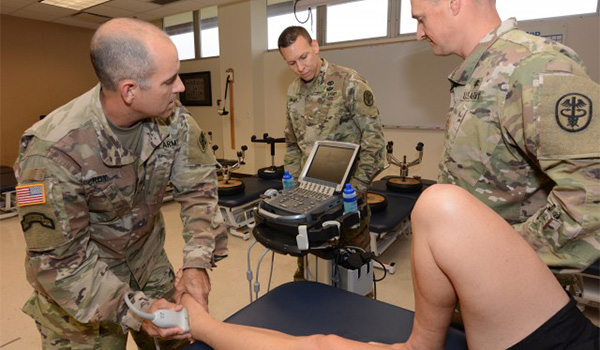
Ask the Flight Surgeon / By CPT Frank C. Stafford, D.O.: Q: I have had shoulder pain for years and I’ve been told I have problems with the muscles and tendons around the shoulder. I read on the internet that Platelet-Rich Plasma (PRP) can help with this kind of problem. Is that true? Will PRP treatments down me?

Photo by Jose E. Rodriguez, army.mil
FS: Platelet-Rich Plasma (PRP) is one of the newer treatments in the category of regenerative medicine. It has been used to treat both acute and chronic tendon and ligament concerns. Tendons and ligaments are both tough bands of fibrous connective tissues with tendons connecting muscles to bones and ligaments connecting bone to bone. Injured tendons and ligaments heal very slowly and often never return to their pre-injury strength. This is mainly due to their poor blood supply that has difficulty delivering enough cells and repair signaling chemicals necessary for repair. PRP is created by using the injured individual’s own blood. Once the patient’s blood is drawn, a centrifuge separates the platelets from the other components of blood. Platelets are round cell fragments that have a central role in blood clotting and the immune system. These platelets contain multiple proteins known as growth factors that stimulate cellular growth, proliferation and healing. Some of these factors encourage the growth of blood vessels that can increase the blood flow to the area. While other factors activate cells called fibroblasts that become the basic building blocks for tendons and ligaments and take an active role in these tissues’ repair.
Benefits or side effects?
Medical researchers believe that injecting PRP into the damaged areas of the tendon or ligament delivers growth factors and associated chemicals to increase healing. Laboratory studies on tissue samples have demonstrated healing changes. However, clinical trials on actual patients have had mixed results with some studies indicating significant positive changes and others showing no change in healing outcomes. One consistent result from all clinical trials is that PRP rarely has significant, harmful side effects. The most common was pain at the injection site comparable to pain from other injections. However, occasional severe pain and swelling has occurred. Interestingly, PRP has been shown to be more successful treating certain areas of the body such as the elbow versus others such as the Achilles tendon of the back of the lower leg. Keep in mind that with PRP treatments there will be a downing period for observation. Provided that your pain is not distracting, and you have adequate function of the injured body part, the PRP local injection has little body-wide effects and you will generally be back flying in a few days.
How is the treatment applied?
The treatment can be done in office where the sample of your blood is prepped for injection. The provider then uses ultrasound to visualize the site for injection and the area is cleaned and numbed. The injection will be placed into the tendon or ligament using ultrasound to guide the placement. Once finished, you will be observed for a short period of time in office to monitor for any concerns. On the day of the procedure, you should bring someone along to drive you home after the treatment. You can anticipate pain at the injection site for at least 1-2 days after the injection. You may use Tylenol/Acetaminophen to control the pain. You should not use ibuprofen, naproxen, Mobic, or other anti-inflammatory drugs for 7 days prior to and after the procedure. Their anti-inflammatory activity could block the inflammation at the site and render the shot ineffective. Your activities are limited to typical daily activities such as getting dressed, fixing meals, etc. You should not do any strenuous activity for about a week after the procedure. It will be six to eight weeks before a full assessment of the treatment’s effectiveness can be determined.
Covered or out of pocket?
These injections are usually given by family physicians, physical medicine physicians, and sports-certified physicians who have the appropriate training. Of note is that civilian insurance will not pay for these services as it is not a widely accepted treatment regimen. Due to this, out of pocket costs range from $500 to $2,000. In the military, it is best to seek out a military provider certified to provide PRP treatment to ensure Tricare coverage.
Is this grounding?
The Aeromedical Policy Letters do not directly address PRP. The local anesthesia requires a minimum of 12 hours of down time. Pain is potentially limiting. If the pain limits egress ability, required range of motion, or distracts you from focusing on flying, then you should not fly. Pain can be controlled with acetaminophen without necessarily grounding you. As always, a frank discussion with your local aeromedical provider is necessary to not only learn about how PRP may affect your safety in flight but to discuss all your treatment options.
Question for the Flight Surgeon?
If you have a question you would like addressed, email it to This email address is being protected from spambots. You need JavaScript enabled to view it.; we’ll try to address it in the future. See your unit flight surgeon for your personal health issues.The views and opinions offered are those of the author and researchers and should not be construed as an official Department of the Army position unless otherwise stated.
CPT (Dr.) Frank C. Stafford is a flight surgeon at the School of Army Aviation Medicine, Fort Rucker, AL










